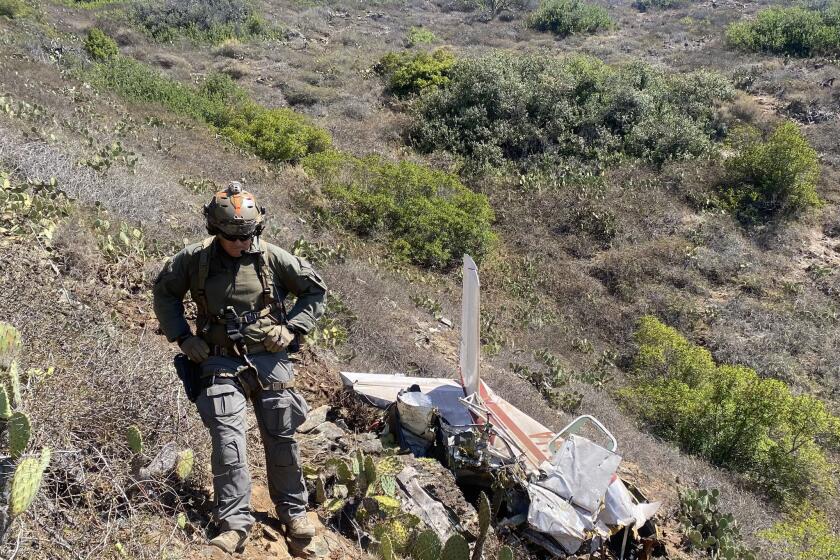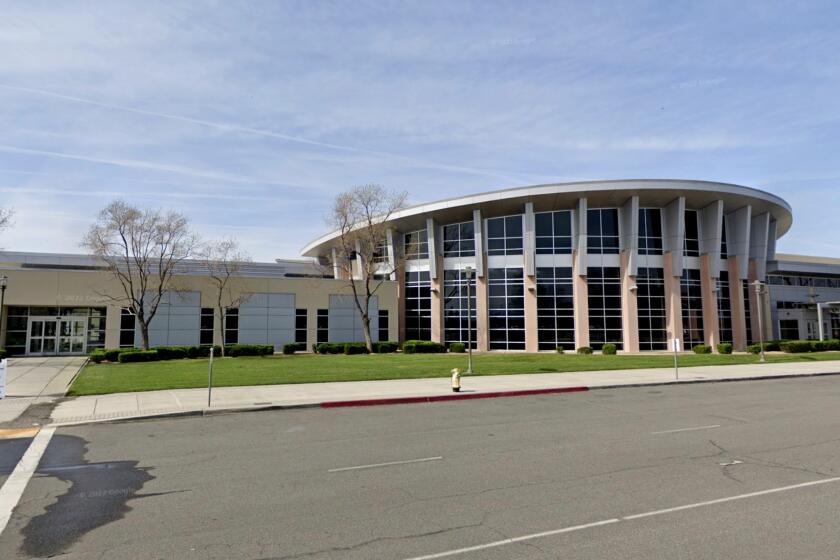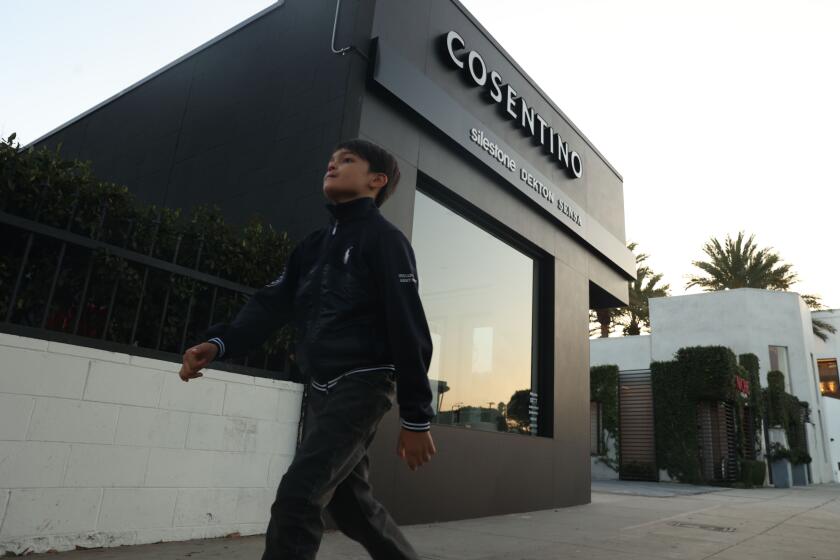Better Service, Lower Costs Aim of Valley Bus System
Supporters and opponents of the Southern California Rapid Transit District agree that the enormous bus system serving Los Angeles County is bursting at the seams.
Although RTD has been grappling for years with the problems of administering the system, some officials say changes have come slowly and have not always benefited riders--especially those in suburban areas like the San Gabriel Valley.
Now a radical proposal from county Supervisor Pete Schabarum is opening the possibility of a major change in bus service in the San Gabriel Valley.
Schabarum’s proposal involves forming a new transportation district, separate from the RTD and controlled by local governments, that would be run by private bus operators. Last Tuesday the county Board of Supervisors endorsed the county’s participation in the plan by a 3-1 vote.
The new 350-square-mile district would be broken into six small zones that each would handle up to six local or express bus routes.
RTD would continue to run about 53% of the buses it currently operates in the San Gabriel Valley, as well as maintain all bus stops, provide route information and distribute bus schedules for the new district.
Only Difference Would Be Cosmetic
For the bus rider, the switch from RTD to a new transportation district would hardly be noticed, said William P. Forsythe, a county consultant who is serving as project director for the proposed San Gabriel Valley Transportation Zone.
The new district would have the same bus routes, the same fares and the same transfer points. “The only difference to the public is that the bus may have a little different paint,” Forsythe said.
The proposal is being promoted as a way to not only cut the cost of bus service through competitive bidding, lower labor costs and less overhead by as much as $14 million a year but also to improve service through increased local control.
The proposal has been endorsed by the supervisors and 10 of the 29 cities in the San Gabriel Valley. In order to be approved by the commission the proposal must demonstrate the potential for a 25% savings in the cost of running bus service in the area, and be endorsed by all 29 cities.
Beginning Monday, the public will have a chance to comment on the proposal at three public hearings.
Hearings are scheduled for Monday in San Dimas, Tuesday in El Monte and Wednesday in Temple City, all in the county public libraries in those cities starting at 7 p.m.
While the proposal seems to be winning some support, it is also being questioned by some labor leaders, the RTD and some city officials.
Earl Clark, general chairman of the United Transportation Union, which represents more than 5,000 RTD drivers, said allowing private companies to run the bus system may open the possibility of lower wages and less than professional service throughout the county.
‘They Will Get a Battle’
“They have no intention of starting a zone out there and paying top wages, and they are going to get exactly what they pay for,” he said. “We are going to fight privitization with every means at our disposal. If they want a battle, they will get a battle.”
Albert Perdon, RTD’s assistant general manager for planning and communications, said the proposed district could take money away from other areas that RTD serves and eventually lead to the breakup of the RTD system.
“If you set up a zone, that may be fine for the San Gabriel Valley, but what about the rest of the system?” he asked. “The concern is this could lead to a third zone or a fourth zone or a fifth zone. All of a sudden you don’t have a regional system but would have what we had 30 years ago: a bunch of little systems.”
Even supporters of the proposal agree that there are many risks and uncertainties in forming a new transportation district.
“The main disadvantage is that we are taking a risk. We’re going way out on a limb,” said Claremont Mayor Judy Wright, who is a member of a county committee studying the proposal.
“What if it doesn’t work? Then where are we? There are a lot of unknowns out there,” she said.
Proposed in 1984
Schabarum first proposed the formation of a new transportation district in 1984. The proposal is based on state legislation that allows the county Transportation Commission to form a new district if an existing transportation operator “cannot otherwise provide adequate and responsive local transportation service in a cost-effective manner.” The commission is responsible for setting major policy and allocating state, federal and local funds for transportation.
Forsythe, project director for the proposed transportation district, said the RTD has failed in all those criteria in the San Gabriel Valley.
Because of low ridership and the high cost of providing suburban bus service, the San Gabriel Valley often has been the target of service reductions, he said.
“This is the first place they look to cut,” he said.
Jan Hall, president of the RTD Board of Directors, said the possibility of service reductions is a problem in all county areas.
“It’s like a system that is just bursting at the seams with not many alternatives to keep it from bursting,” she said.
Problems of Scale
Forsythe said many problems can be traced to the enormous size of RTD, which now provides service to 2,280 square miles and carries more than 450 million people a year, according to RTD statistics.
“There is no economy of scale in transit. The larger the transit system, the higher the cost. That is true whether who are talking about Seattle, Dallas, L. A., New York or wherever,” he said. “The more buses you have operating, the more it costs you to run them.”
Although the new district would provide roughly the same service as the RTD, supporters say that its benefit would be the potential for cost savings that eventually could mean cheaper fares and improved service.
Forsythe said the savings would come through competitive bidding between private companies for bus routes and a reduction in overhead. RTD could bid against any private company to provide service for the routes.
According to Forsythe, by 1991, when fully implemented, bus service in the new San Gabriel system would cost about $57 per hour. That figure is based on comparisons with other municipal and private bus operations of similar size, he said. RTD service in 1991 could be expected to cost $85 an hour, he said.
Savings of $14 Million
Schabarum has estimated that the new district could cut local bus transportation costs by as much as $14 million a year in 1991.
The district would be allowed to keep any surplus instead of returning those funds to the county Transportation Commission, as is now required of the RTD. The new district’s savings would be used to improve or expand future service, Forsythe said.
The new district would be run by a joint agency made up of representatives of the county and the 29 San Gabriel Valley cities.
The cities would be broken up into five geographic areas with approximately equal populations. Each area would have one member on an executive board and the county would have two.
The new district would employ a staff of seven, which would oversee operations of the private companies, according to the proposal.
Private Transfer
The transfer of bus service to private companies has already been implemented in other parts of the country, including Snohomish County in Washington state and Dallas.
Ken Graska, executive director of Community Transit of Snohomish County, said his county has been using a private company for the last four months to run 10 express routes previously operated by the Seattle bus system.
He said the county estimates it will save about $200,000 this year because of the switch, somewhat less than originally expected. Much of the savings have come from cheaper labor contracts, which now pay bus drivers $6.50 an hour, contrasted with the nearly $12 an hour union bus drivers in Seattle are making, he said.
While the overall savings have not been what the county expected, Graska said that having a private contractor provide service has given the county more flexibility and control over bus routes.
“We’re adding more people and more service, definitely,” Graska said.
Expansion Considered
He said the county is considering allowing private companies to run the county’s local service.
Michael York, assistant executive director for operations of the Dallas Area Rapid Transit, said private operation of local and express routes in the Dallas area has been economical and efficient.
“The private carriers are doing it cheaper and the service is excellent,” he said. But he added that private companies, whose main priority is profits, must be closely monitored.
“We have to hold their feet to the fire,” he said.
The United Transportation Union’s Clark said private companies will certainly seek lower salaries for mechanics and drivers, and that prospect will mean less qualified workers. RTD drivers now make up to $13.76 an hour, he said.
‘Get What They Pay For’
“There’s no doubt it will be cheaper, but they will get what they pay for,” he said.
He said the union, whose membership includes about 700 workers in San Gabriel Valley RTD operations, will fight any attempt to lower wages.
“They’re going to have labor problems right away,” he said.
Clark also said that some important questions, such as who will provide security for the bus system, have not been answered.
Forsythe stressed that the new district will maintain all service that the RTD now provides.
Top Priority: Money
But Clark said he doubts that because “instead of service being the top priority, money will be the top priority.”
Perdon of the RTD said there is only a limited pool of federal, state and local funds available for bus transportation and that money switched from RTD to the new district eventually could result in less money for RTD service in other areas.
For example, the proposal requests a guaranteed base annual subsidy of $31 million dollars once the program is fully implemented in 1991. If federal and state revenue to the county decreases, money will have to be taken from RTD to support the new district’s guaranteed subsidy, he said.
“The (San Gabriel Valley Transportation) zone would get more money no matter what happens to anyone else,” Perdon said.
He also questioned whether the new district could come up with the cost savings outlined in the proposal.
‘Balkanization’ Feared
The new district also could encourage other areas to form their own transportation districts, resulting in a “Balkanization” of bus service in the entire county, Perdon said.
The result could be poor coordination of service, political bickering between various districts and confusion for the public, he said.
Perdon said responsibility for county bus transportation is already split between the RTD and the county Transportation Commission. He said more districts would only make the system more cumbersome and less responsive.
“Who will be held accountable?” he asked. “Who will assure that the system is all working?”
Forsythe said the proposal is not aimed at breaking up the RTD system because RTD still would provide more than half of bus service in the valley.
More Responsive
He added the new district would be more responsive than RTD because it would be run by officials from the San Gabriel Valley.
Although the county and 10 cities--Baldwin Park, Claremont, Covina, Duarte, Irwindale, La Verne, Pomona, San Dimas, Temple City and Walnut--have endorsed the proposal, many city officials are not sold on the idea.
Some cities in the eastern valley, like Pomona, have supported it because they believe that they are vulnerable to service cutbacks because of their distance from Los Angeles and relatively low ridership.
“Too frequently we hear RTD is going to change routes or eliminate them and our citizens are getting very nervous,” said Pomona Mayor G. Stanton Selby. “We feel the way the valley proposal is laid out, it answers many of our problems.”
But in the western end of the valley, which has a higher concentration of commuters, support for the proposal is more problematic.
Assessing Risk
Pasadena Transportation Commission Chairwoman Nancy Leon said the RTD is a known quantity, which has provided acceptable service, and it would be a risk to go with a new district.
She added, “We all want more than what we’ve got. We all wish we had more service and lower fares.”
According to a 1984 county study, Pasadena accounts for about one-fourth of all bus boardings in the San Gabriel Valley.
The city Transportation Commission is expected to issue a recommendation on the proposal in March, Leon said.
Rosemead is the only city that has come out against the plan. Rosemead Mayor Jay T. Imperial said, “The (City) Council felt the service is adequate. Why take an action when it isn’t needed?”
Before the proposal receives final approval from the county Transportation Commission, it first must be endorsed by the county and all 29 cities involved. Then 8 of the Transportation Commission’s 11 members must approve it.
The final step would be negotiations to form the new district’s Joint Powers Authority. Service gradually would shifted to the new district over 18 months.
More to Read
Sign up for Essential California
The most important California stories and recommendations in your inbox every morning.
You may occasionally receive promotional content from the Los Angeles Times.










